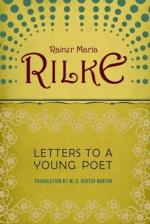
|
| Name: _________________________ | Period: ___________________ |
This test consists of 15 multiple choice questions and 5 short answer questions.
Multiple Choice Questions
1. Rilke indicates that in the future, men and women will approach each other differently than they do at the time of his writing. How will they approach each other?
(a) Not as lovers, but as friends.
(b) Not as opposites, but as human beings.
(c) Not as enemies, but as friends.
(d) Not as sexual objects, but as human beings.
2. Rilke says that there is only one thing that "can grasp and hold and be just toward" art. What is that thing?
(a) Creativity.
(b) Hope.
(c) Love.
(d) Open-mindedness.
3. What does Rilke believe is wrong with sex?
(a) It goes against Christianity.
(b) It subordinates women.
(c) It is not wholly human and is based on temporary emotions.
(d) It distracts the artist from his work.
4. What acquaintance do Rilke and the young poet have in common?
(a) Professor Horacek.
(b) James Joyce.
(c) Professor Kruppa.
(d) A distant cousin.
5. In the fourth letter, who does Rilke say is more similar than people think?
(a) Officers and prisoners.
(b) Humans and animals.
(c) Men and women.
(d) Artists and farmers.
6. From where does Rilke instruct the young poet to derive inspiration?
(a) Nature, common human experiences, and memories.
(b) The words of other poets.
(c) The political climate of the times.
(d) Music.
7. Whose ideas about sex does Rilke advise the young poet to avoid subscribing to?
(a) Jens Peter Jacobsen's.
(b) Professor Horacek's.
(c) Richard Dehmel's.
(d) Rilke's own.
8. In the first letter, what does Rilke cite as the most disruptive hindrance to the young poet's progress?
(a) Looking for others to answer the poet's own personal questions.
(b) Drinking.
(c) Non-artistic work.
(d) Romantic entanglements.
9. How does Professor Horacek know Rilke?
(a) Professor Horacek teaches Rilke at a military academy.
(b) Professor Horacek raises Rilke.
(c) Professor Horacek knows Rilke's grandfather.
(d) Professor Horacek is Rilke's editor.
10. If the young poet discovers he should not be a poet, Rilke suggests that his inner examination will not be worthless. Why not?
(a) The young poet might then discover his talents for music.
(b) The young poet may be able to have a well-paying career.
(c) The young poet may discover that he has a spiritual calling.
(d) The inner examination will result in the young poet determining a different course that may be better for the young poet.
11. What does Rilke suggest that all humans share in, both women and men?
(a) Reverence.
(b) Transcendence.
(c) Spirituality.
(d) Motherhood.
12. Who does Rilke tell the young poet to be considerate of because of their fear of solitude?
(a) Children.
(b) Artists who have not yet found their way.
(c) The elderly.
(d) Parents.
13. What does Rilke say the young poet should do if he determines he should not be a poet?
(a) He should pursue the visual arts.
(b) He should join the military.
(c) He should pursue the musical arts.
(d) He should quit writing completely.
14. How does Rilke suggest one knows if one should not be a poet?
(a) If one does not like to read others' poetry.
(b) If one is bored by one's own writing.
(c) If one can live without writing.
(d) If one cannot get published after 100 tries.
15. In the third letter, Rilke requests that the young poet avoid something. What is it that he asks the poet to avoid?
(a) Reading contemporary literature.
(b) Drinking.
(c) Reading aesthetic criticism.
(d) Studying science.
Short Answer Questions
1. What writer and personal acquaintance does Rilke discuss in letter three?
2. Rilke writes that "most events are inexpressible," and says that one category of things is more inexpressible than all the rest. What is this category?
3. What does Rilke thank the young poet for at the end of the first letter?
4. What does Rilke tell the young poet about irony?
5. In what year is the first letter from Rilke to the young poet written?
|
This section contains 639 words (approx. 3 pages at 300 words per page) |

|




